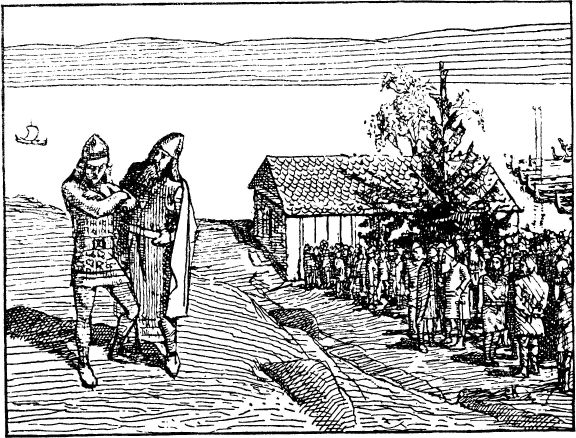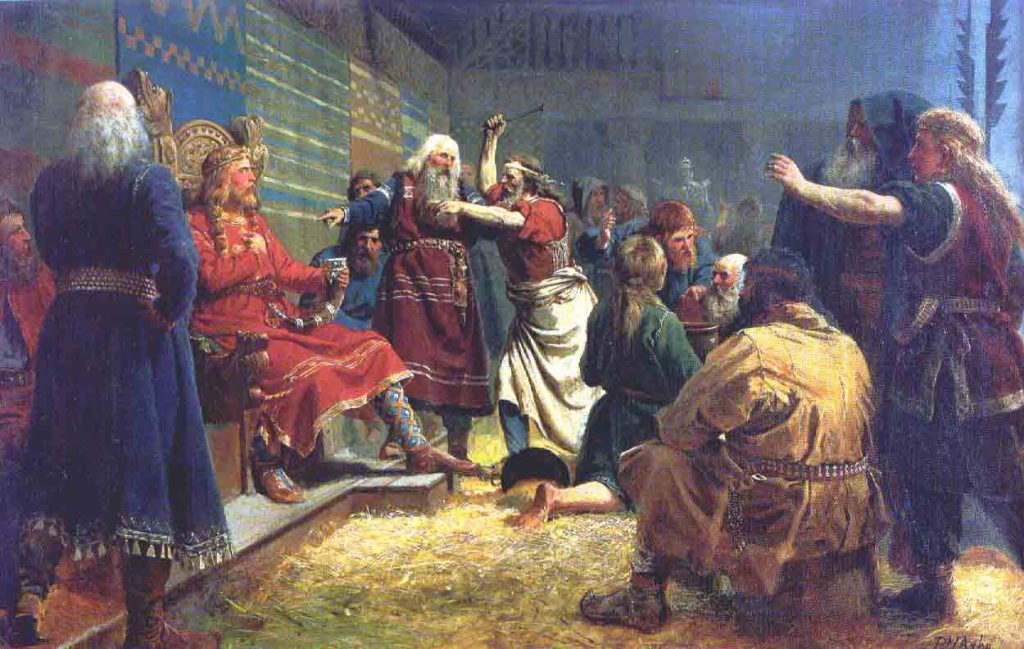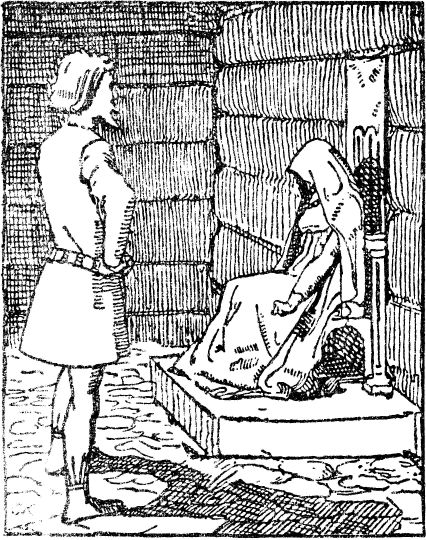
Sigurd Ladejarl with King Haakon the Good. Drawing by Christian Krohg, 1899
Around the year 934 news of Harald’s death reached Northumbria and Haakon “immediately made himself ready to depart.” King Athelstan sanctioned his journey by giving him “men, and a choice of good ships, and fitted him out for his journey most excellently.” Haakon set sail for the capital of Trondheim and there met Sigurd Earl of Lade, “the ablest man in Norway.”

The Earl received him warmly and the two “made a league with each other, by which Hakon promised great power to Sigurd if he was made king.” This alliance proved fruitful but what delivered the people to his side was the public promise to give “every man udal rights to the land he lived on. This speech met such joyful applause…” Although there were those who heard and believed that “‘Harald Harfager is come again’” in the form of his youngest son, the vow to return landholders’ ancient rights was ironically a repudiation of the very policy that cemented his father’s power in Norway. The restoration of land rights clinched Haakon’s position and made him instantly beloved:
And so it was that the Throndhjem people took Hakon, who was then fifteen years old, for king; and he took a court or bodyguard, and servants, and proceeded through the country. The news reached the Uplands that the people in Throndhjem had taken to themselves a king, who in every respect was like King Harald Harfager, – with the difference, that Harald had made all the people of the land vassals, and unfree; but this Hakon wished well to every man, and offered the bondes to give them their udal rights again, which Harald had taken from them. All were rejoiced at this news, and it passed from mouth to mouth, – it flew, like fire in dry grass, through the whole land, and eastward to the land’s end. Many bondes came from the Uplands to meet King Hakon.[1]
Athelstan’s Mediation
That winter Haakon received the blessings of the people in the Uplands and was hailed as king at every gathering, and thus “hatred to King Eirik grew more and more, the more liking all men took to King Hakon; and they got more boldness to say what they thought.” In the spring of 935 Haakon amassed a large force at Trondheim to battle Eric, and Eric attempted to do the same but realized “the leading men left him” to support his younger brother. As a result, Eric believed he was “not nearly strong enough to oppose Hakon,” and thus set sail “to Orkney, and took many people with him from that country; and then went south towards England, plundering in Scotland, and in the north parts of England, wherever he could land.” After hearing of Eric’s ouster, Athelstan, a loyal friend of Harald’s, “sent a message to Eirik, offering him dominions under him in England; saying that King Harald his father was a good friend of King Athelstan, and therefore he would do kindly towards his sons.” According to the Heimskringla, it was the Northumbrian king who mediated a bloodless solution. After sending messengers between each other, it was agreed…
…that King Eirik should take Northumberland as a fief from King Athelstan, and which land he should defend against the Danes or other vikings. Eirik should let himself be baptized, together with his wife and children, and all the people who had followed him. Eirik accepted this offer, and was baptized, and adopted the right faith.[2]
Eric’s Obscure Death
There are conflicting accounts of Eric Bloodaxe’s reign and demise in northern England. When Athelstan passed away in 939 the Norse king’s legitimacy was questioned by Jatmund – Athelstan’s brother and king of England who selected a man named Olaf to rule a realm he believed was his to inherit. Snorri says Jatmund “was no friend to the Northmen. King Eirik, also, was in no great favour with him; and the word went about that King Jatmund would set another chief over Northumberland.” Eric was thought to have perished in a great the battle around 944 and his family fled the country:
When Gunhild and her sons knew for certain that King Eirik had fallen, after having plundered the land of the King of England, they thought there was no peace to be expected for them; and they made themselves ready to depart from Northumberland, with all the ships King Eirik had left, and all the men who would follow them. They took also all the loose property, and goods which they had gathered partly as taxes in England, partly as booty on their expeditions. With their army they first steered northward to Orkney… and took up their station there for a time. Eirik’s sons subdued these islands and Shetland, took scat for themselves, and stayed there all the winter; but went on viking cruises in summer to the West, and plundered in Scotland and Ireland.[3]
The Anglo-Saxon Chronicle says that in the year 954 the “Northhumbrians expelled Eric,” which is generally believed to be the year the decisive Battle of Stainmore in Cumbria was fought in which Eric and other nobles were slain.

For that reason, along with numismatic evidence of coins minted in York, it is believed Eric was ousted sometime in the late 940s and reinstated in the early 950s, but nevertheless was fated to be the last king of Northumbria – as England’s growing power rose to reconquer what had been lost to the Great Heathen Army nearly two generations before.[4] What is not in doubt, however, was that Eric’s sons believed their destiny lay in the Norwegian throne their grandfather Harald had bestowed upon his favorite son. They believed it was stolen from their father, and thus were determined to wrest it from Haakon, or die trying.
[1] Laing, The Heimskringla or the Sagas of the Norse Kings From the Icelandic of Snorre Sturlason, vol. 2, 3-4.
[2] Ibid. 5-6.
[3] Ibid. 7-9 The earl of Orkney was Thorfin Hausakliufer, a son of Torf-Einar and grandson of Rognvald, King Harald Fairhair’s old friend.
[4] John A. Giles, The Anglo-Saxon Chronicle (London: G. Bell and Sons, 1914), 77. See: William G. Collingwood, “King Eirík of York,” Saga-Book 2 (1897): 313–27. “The object of this paper is to show that the ‘Heimskringla’ and English chroniclers have the same story about the death of Eirík last king of York.” For numismatic evidence (‘King Eric’ coins) discovered in the nineteenth century, see: R. H. M. Dolley, “An Important Group of Tenth-Century Pence,” The British Museum Quarterly 21, no. 3 (1958): 74–76; R. H. M. Dolley, “The ‘Lost’ Hoard of Tenth-Century Anglo-Saxon Silver Coins from Dalkey,” The Journal of the Royal Society of Antiquaries of Ireland 91, no. 1 (1961): 1–18; R. H. M. Dolley, “A Hoard of Anglo-Saxon Pennies from England,” The Numismatic Chronicle and Journal of the Royal Numismatic Society 1 (1961): 151–61.
About the author
Benjamin J. Swenson is an assistant professor at Hoseo University in Asan, South Korea. He holds a PhD from Pompeu Fabra University in Barcelona, Spain, where his dissertation addressed Euro-American military history and the advent of guerrilla warfare and counterinsurgency doctrine in the nineteenth century. His work has recently appeared in the Journal of Military History, and his latest, The Dawn of Guerrilla Warfare, will be published by UK’s Pen & Sword in 2023. His hobbies include Viking sagas and chess.